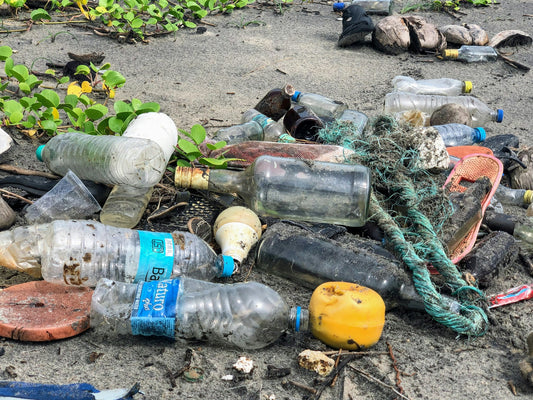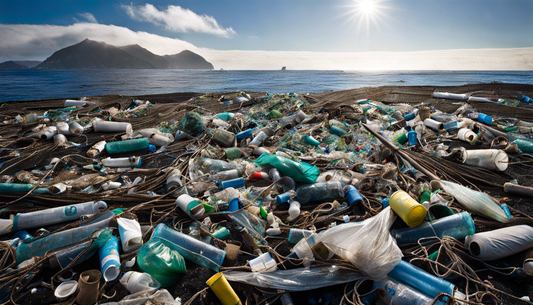Share
When it comes to environmental degradation, some industries are known to be the biggest culprits due to their high pollution impacts.
Most of us are aware of the significant impact of the transportation industry, agriculture, or the oil and gas industries.
Yet, amidst these well-publicized offenders, there is a quieter but no less significant culprit: the fashion industry.
Fashion is one of the most common aspects of our daily lives and is easily overlooked despite the fact that it has a great impact on the environment from the time it is produced to the time it is disposed of.
The clothes we wear, the manufacturing methods used to produce them, and even the manner in which we dispose of them all contribute to the fashion industry's terrible impact on the environment.
In this article, we will examine the full extent to which the fashion industry pollutes our planet.
To your surprise, the clothing industry is said to contribute 10% of global carbon emissions. This means that this industry alone emits more carbon than international flights and maritime shipping combined.
In What Ways Does The Clothing Industry Pollute the Environment?
There are various ways in which the clothing industry can pollute our planet. From start of the production of clothes to the end, there are various polluting processes included in the life cycle of clothes.
1. The Process of Fabrication

Cotton Farming
It is estimated that approximately 2,700 liters of water are needed to make one cotton t-shirt, which is the amount of water that a person uses for drinking over 2.5 years.
Cotton farming involves use of pesticides, which have negative impacts on the environment and human health.
Cotton production is responsible for 16 percent of global insecticide usage and 7 percent of pesticide usage.
Synthetic Fibers:
Fabrics such as polyester, nylon, and acrylic fabrics are made from a non-renewable resource which is petroleum. The production of polyester alone releases 706 billion kg of greenhouse gases every year, equivalent to 185 coal-fired power stations.
Microfibers released from synthetic wear during washing contribute to plastic pollution in our waters. According to a report, a single polyester garment can release approximately 1,900 microfibers when washed.
Dyeing and Finishing:
Different chemicals are used in dyeing and finishing textiles, and many of them are toxic and carcinogenic.
Approximately twenty percent of industrial water pollution comes from the dyeing and treating of textiles.
Textile dyeing facilities located in countries with weak environmental standards release untreated wastewater into water sources, polluting aquatic life and compromising the health of the communities living nearby.
2. The Fast Fashion Phenomenon: A Race to Destruction

In recent decades, the fashion industry has seen a great change due to the popularity of fast fashion with consumers. Fast fashion brands release new products frequently to meet the demand for the newest fashion trends at a low cost.
However, this high rate of production and consumption poses a big problem to the environment.
Fast fashion is based on the model of consumption, in which clothing items are worn for a short period of time before they are replaced.
The consequence of such a strategy is that people start perceiving clothing as something that is not meant to last, and as a result, it becomes a disposable item rather than an investment.
Overproduction and Overconsumption
Fast fashion brands design and manufacture clothing in large quantities to meet the ever-evolving fashion trends and customer wants.
This overproduction is not only responsible for the excess stock but also results in the consumption of raw materials and the generation of waste.
The fashion industry alone is responsible for generating 92 million tons of textile waste per annum, which is equivalent to one truckload of clothing being buried or burnt every second.
Environmental Degradation
Fast fashion garments are produced globally in countries with poor environmental policies; therefore, polluting emissions from textile dyeing, chemical processing, and disposal of waste are not controlled.
The fashion industry consumes 20% of the world’s water and is anticipated to increase in greenhouse gas emissions by 50% by 2030.
3. Supply Chain of Fashion and Its Impact on Pollution

The fashion industry is inherently global, where fabric is produced from one country, cut and sewn into garments in another country and sold to customers in yet another country.
These supply chains include the use of several means of transport that have an impact on the environment.
Around 1.2 billion tonnes of carbon are emitted by the fashion industry every year, which makes it the second most polluting industry after fuel and energy production.
While the publicly available numbers do not break down the specific impact of the fashion supply chain, we can be certain that they are responsible for a big fraction of the overall impact.
Air Transportation
Air transportation is widely used to transport perishable and valuable fashion products like clothing, accessories, and seasonal products.
However, it brings in high environmental costs because of its high carbon footprint.
Sea Transportation
Seaborne transport is most widely used in the transportation of fashion goods, especially large volume shipments of textiles, apparel, and accessories.
Ships are known to be more fuel efficient than airplanes, but they still contribute significantly to greenhouse gas emissions.
Land Transportation
When clothing gets to the final destination, the clothes are taken to the market by means of trucks.
Although land transportation is relatively less energy-intensive compared to aviation and maritime transport, it also has environmental impacts, especially in areas with traffic congestion.
4. Packaging and Waste: The Inherent Overhead of Fashion Distribution

Apart from the emissions that come with transportation, there is also a significant amount of packaging waste that comes with the distribution of clothing.
Fashion items are packed in plastic polybags to protect them during transportation and this polybags, cardboard boxes and paper tags used in packaging fashion products harm the environment in various ways such as polluting the environment and depleting natural resources.
A considerable number of fashion brands use plastic packaging materials that are used once and then disposed of, contributing to environmental pollution.
As mentioned above, the fashion industry generates about 92 million tons of textile waste annually, there is a significant amount of plastic waste in this.
Consumers Have the Power to Vote Their Wallets
It is very important to be informed about the effects that the fashion industry has on the environment and society.
With these problems in mind, it is easier to make a better choice in the market and buy products from companies with a positive attitude towards the environment.
People must change their mentality toward clothes. They must stop buying new clothes every season and start thinking more responsibly. They must stay away from cheap products, opt for better materials, and always aim for long-lasting items.
Did you know the fashion industry has such a high environmental footprint? Feel free to leave a comment below.
We hope you enjoyed this article. If you want to read more like this, make sure to check out our Blog and follow us on Instagram. If you are interested in truly sustainable products, check out our Shop.








